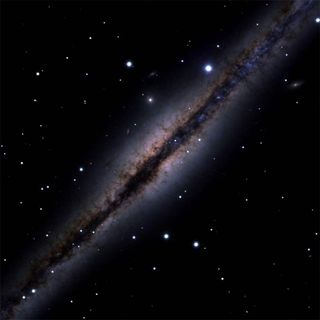New View: Universe Suddenly Twice as Bright

The universe is twice as bright as it appears, astronomersnow suggest.
The light bulb went on when they calculated that dust blocksabout the half the light emitted from stars and galaxies.
Astronomers have known about interstellar dust for a while,but they haven't been able to quantify just how much light it blocks. Now ateam of researchers has studied a catalogue of galaxies and found that dustshields roughly 50 percent of their light.
"I was shocked by the sheer scale of the effect,"said Simon Driver, an astronomer from the University of St. Andrews in Scotlandwho led the study. "Most people just kind of said, 'We suspect dust is aminor problem.' I spent much of my career working on deep images from Hubbleand I've always ignored dust almost entirely."
The result will likely cause many astronomers to revisetheir calculations of the intrinsic brightness of many celestial objects,Driver said. Until now, many astronomers thought stars and galaxies were reallyabout 10 percent brighter in optical light than they appeared because of dust.If the new findings are true, it turns out that objects in the sky are abouttwice as bright than they appear.
"This is a strong, clear-cut result," Driver toldSPACE.com. "We've really got to take dust seriously and we've got tomake large adjustments to our magnitude calculations." (A magnitude scaleis used to define brightness of celestial objects.)
The astronomers detailed their findings in the May 10 issueof the Astrophysical Journal Letters.
Get the Space.com Newsletter
Breaking space news, the latest updates on rocket launches, skywatching events and more!
Interstellardust isn't exactly the same thing that coats our bookshelves and covers ourTV screens. It's made up of lumps of carbon and silicates that form dust grainsonly a few thousandths of a millimeter long. It hangs out in galaxies, butgenerally steers clear of the space between them.
To calculate dust's effect, the researchers analyzed datafrom the Millennium Galaxy Catalogue, a collection of images of 10,000 galaxiescompiled by Driver and his team using the Isaac Newton Telescope on La Palmaand others.
They counted the number of galaxies in the catalogue thatwere directly facing us, and compared it to the number that were tilted 90degrees away from us. Without dust, they reasoned, they should see just aboutequal numbers of galaxies in each orientation. But with dust, they would likelyfind fewer edge-on than face-on galaxies. Since dust lies in the disks ofspiral galaxies, and not the dense central bulge,when we view galaxies from the side we are looking through thicker layers ofdust, so we should see less light. In fact, the researchers counted about 70percent fewer edge-on galaxies than face-on galaxies.
They used this discrepancy to quantify dust's effect bycombing their counts with a model of dust distribution in galaxies developed byCristina Popescu of the University of Central Lancashire and Richard Tuffs ofthe Max Plank Institute for Nuclear Physics.
"It's been a revelation to many people in thecommunity, but there are small groups that had a suspicion this wascoming," Driver said. "I wouldn't be surprised if there's arefinement of the result, but I think the result is basically here tostay."
The research was funded by the Science and TechnologyFacilities Council, the Australian Research Council, the Max-Planck Society anda Livesey award from the University of Central Lancashire.
- Life's Little Mysteries: Why Do Stars Twinkle?
- Video: Red Dust Dangers
- Image Gallery: Hubble Photos - When Galaxies Collide
Join our Space Forums to keep talking space on the latest missions, night sky and more! And if you have a news tip, correction or comment, let us know at: community@space.com.

Clara Moskowitz is a science and space writer who joined the Space.com team in 2008 and served as Assistant Managing Editor from 2011 to 2013. Clara has a bachelor's degree in astronomy and physics from Wesleyan University, and a graduate certificate in science writing from the University of California, Santa Cruz. She covers everything from astronomy to human spaceflight and once aced a NASTAR suborbital spaceflight training program for space missions. Clara is currently Associate Editor of Scientific American. To see her latest project is, follow Clara on Twitter.
